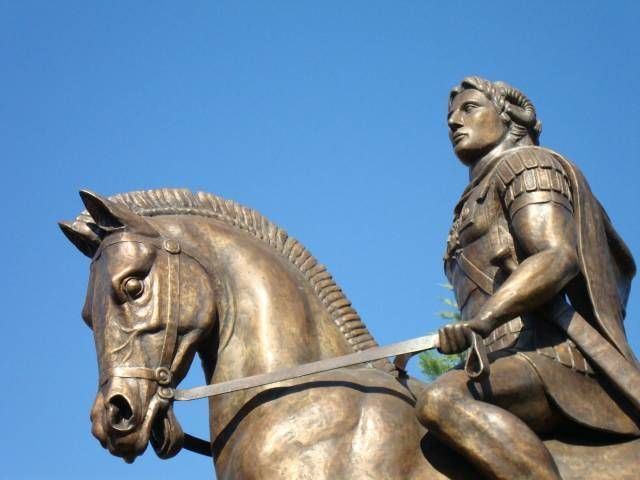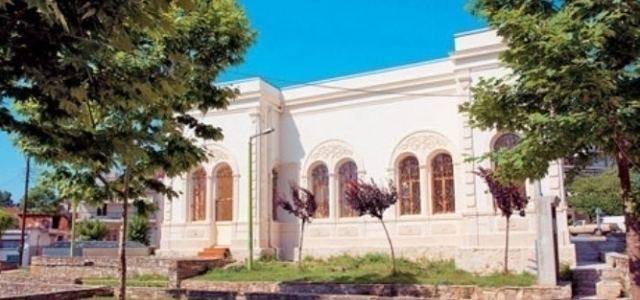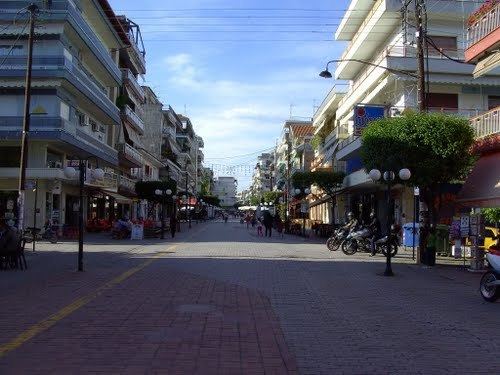Country | Mayor Gr. Stamkos | |
 | ||
Map of Giannitsa
Giannitsa (Greek: Γιαννιτσά [ʝaniˈt͡sa], in English also Yannitsa, Yenitsa) is the largest city in the regional unit of Pella and the capital of the Pella municipality, in the region of Central Macedonia in northern Greece.
Contents
- Map of Giannitsa
- giannitsa
- Name
- History
- Landmarks
- Economy
- Notable people
- Entertainment
- Loudias river
- Districts
- Newspapers
- TV station
- Online Newspapers
- Sports
- Twin towns Sister cities
- References

The municipal unit Giannitsa has an area of 208.105 km2. Its population is 31,983 people (2011 census). It includes a few outlying villages (Mesiano, Melissi, Pentaplatanos, Archontiko, Ampelies and Damiano). The municipality Pella as a whole includes many villages and has 63,122 inhabitants. The city is located in the center of Macedonia between Mount Paiko and the plain of Giannitsa, and is the economic, commercial and industrial center of the Pella regional unit. European route E86 (Greek National Road 2) runs along the south of the city.

The former shallow, swampy, and variable-sized Giannitsa Lake or Loudias Lake, fed by the Loudias River and south of the city, was drained in 1928-1932 by the New York Foundation Company.
About 7 km (4 mi) from Giannitsa are the ruins of ancient Pella, birthplace of Alexander the Great and capital of ancient Macedonia. The city is 48 km (30 mi) from Thessaloniki.
giannitsa
Name
The city was founded as Yenice-i Vardar 'new (town) of Vardar' in around 1372. It was sometimes called Evrenos Beg yöresi 'Evrenos Bey's town'.
The Turkish name, in the form Γενιτσά, was used until February 1926 when its name was Hellenized as Yannitsa/Γιαννιτσά. In other languages, the city is called: Ottoman Turkish Yenice-i Vardar ('new-town of Vardar', as opposed to Yenice-i Karasu, modern Genisea, near Xanthi and known for tobacco), Turkish Yenice or Vardar Yenicesi, and Macedonian: Ениџе Вардар, Enidže Vardar or Пазар Pazar 'market'.
History
Prehistoric
In the area of "Old Market", on the southern hill of the city, there was an Early Neolithic settlement (late 7th to early 6th millennium BC). Giannitsa was also inhabited through the Bronze and Iron Ages. Incidental findings, such as coins, inscriptions, and sculptures indicate that the area was inhabited during the Hellenistic period (323-30BC). In ancient times, the area was called Bottiaea.
Ottoman
Though there was probably a pre-existing Byzantine castle in the vicinity, the importance of the city of Yenije begins with its foundation by Gazi Evrenos in around 1372. Yenije became the base of the ghazi followers of Evrenos who took Macedonia and later Albania. The city was an important Ottoman cultural center and sacred area in the 15th and 16th centuries. Starting in the mid-15th century, Yenidje became a center of literature and the arts. Under Ahmet Bey, a descendant of Gazi Evrenos, many mosques, schools, workhouses and charitable projects were founded.
In the early 20th century, Yenije was a battleground between Bulgarian and Greek-Macedonian partisans in the Macedonian struggle. Penelope Delta's novel Secrets of the Swamp (referring to the shores of Giannitsa Lake) is a romanticised account of this from the Greek point of view.
Balkan wars
Yenidje "retained its emphatically Turkish character up to 1912" and members of the Evrenos family lived in the city in a large palace in the center of town until then. In the First Balkan War, the Battle of Yenidje (20 October 1912) was one of the most important battles the Greek army fought.
German occupation
The German army invaded Giannitsa on April 11, 1941 . On April 20, 1941, some Austrian forces arrived. The municipal registry of Giannitsa confirms four random killings in various parts of the city. On 16 September 1943, the Municipality of Giannitsa, headed by the Mayor, Thomas Magriotis and the help of local soccer teams organized a demonstration in the city and indulge in German commandant a text against the intention of the Germans to surrender Central Macedonia to the Bulgarians. According to oral testimony on November 13, 1943, the Germans arrested around 50 people, whom they transferred to the camp of Pavlos Melas at Thessaloniki and they killed thirteen. At the same time, the Germans invaded for the first time the village Eleftherohori 7 km (4 mi) away from the city, steal and destroy. In this attack there were no casualties. On 23 March 1944, the village was burned, and the place deserted. Eleftherohori lost 19 lives. On 5 August 1944, the Austrian soldier Otmar Dorne left the German occupation army and joined the 30th Constitution of the E.L.A.S, based in Mount Paiko. The defection of Dorne, and the presence of the SS sergeant Schubert, led to mass reprisals on 14 September 1944 in Giannitsa: about 120 residents of Giannitsa were executed by forces of the Jagdkommando Schubert with the collaboration of Greek units under the command of G. Poulos. Among those executed was the Mayor, Thomas Mangriotis. The Swedish ambassador Timberg indicated that one third of the city was destroyed by fire. The citizens left the city. Emile Wenger visited Giannitsa few days after the mass execution, as a representative of the International Red Cross and wrote "Giannitsa is already a dead city". On 20 September 1944, a citizens' committee sent a message to the National Government stating the facts and asking for weapons. The Germans left Giannitsa on November 3, 1944.
Landmarks
Monuments
Yenidje was an important center in the Ottoman period, and several important monuments survive: Tombs of Gazi Evrenos (Built in 1417) and Gazi Ahmed Bey, Kaifoun Baths, the Great Mosque, the Army Mosque, the hammam of Evrenos, and the Clock Tower (It was built from 1667 to 1668 by Ottomans. The choice of location was made with military criteria because they wanted to control the commercial activity that was taken place across the city throughout central Macedonia). These monuments have been declared historical monuments by the Greek Archaeological Service.
Points of interest include also the Cathedral Church of Giannitsa (1860), the Neoclassical Multicenter, the Filippeio tourist center, the Macedonian tombs, and the prehistoric settlement of Archontiko.
Museums
Statues
Aravyssos
Economy
Giannitsa is predominantly a rural area. The draining of the Lake Giannitsà left fertile soil for agriculture, leading to population growth in the region.
Notable people
Entertainment
The focus of the social life of the city is at the central pedestrian street, where people gather to eat and drink or to take a walk. Giannitsa was one of the first cities that founded Open Theatre (3000 seats) and became an institution for cultural events and big names in theater and music, every year, the last month of summer giving a culture festival character . Also various theatrical and musical events take place in a closed theater located internally of the Cultural Centre which has a modern architecture. In the first days of September there is a big market for about a week. Also DI.K.E.P.A.P. (ΔΗ.Κ.Ε.Π.Α.Π) is a charitable non -profit cultural organization founded in 1996 that develops music, visual arts, dance, film and other arts.
Loudias river
Seven kilometers (4.3 miles) south of the center is the Loudias River, which has a sailing center. The Nautical Club of Giannitsa (NOG) teaches canoeing, kayaking, and rowing.
Districts
Newspapers
TV station
Online Newspapers
Sports
The most popular team is the Anagennisi Giannitsa football team which plays at the Municipal Stadium.
There is a motocross track northwest of the city, in the foothills of Mount Paiko, where local, Greek, and European races are run.
At the river Loudias, there are rowing races in which the Nautical Club participates.
Twin towns – Sister cities
Giannitsa is twinned with:
